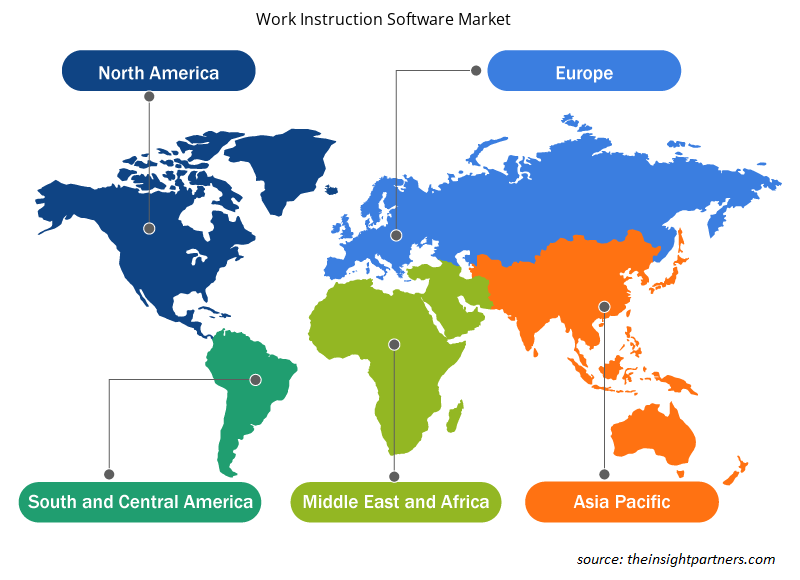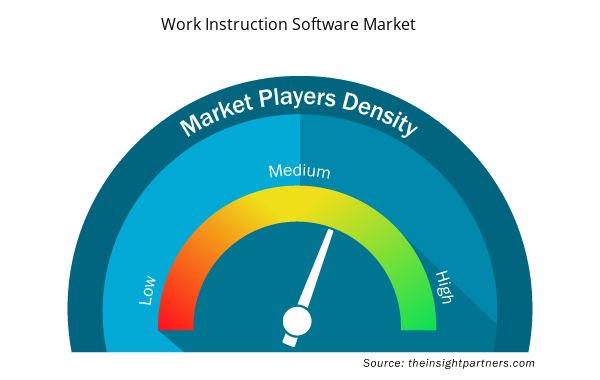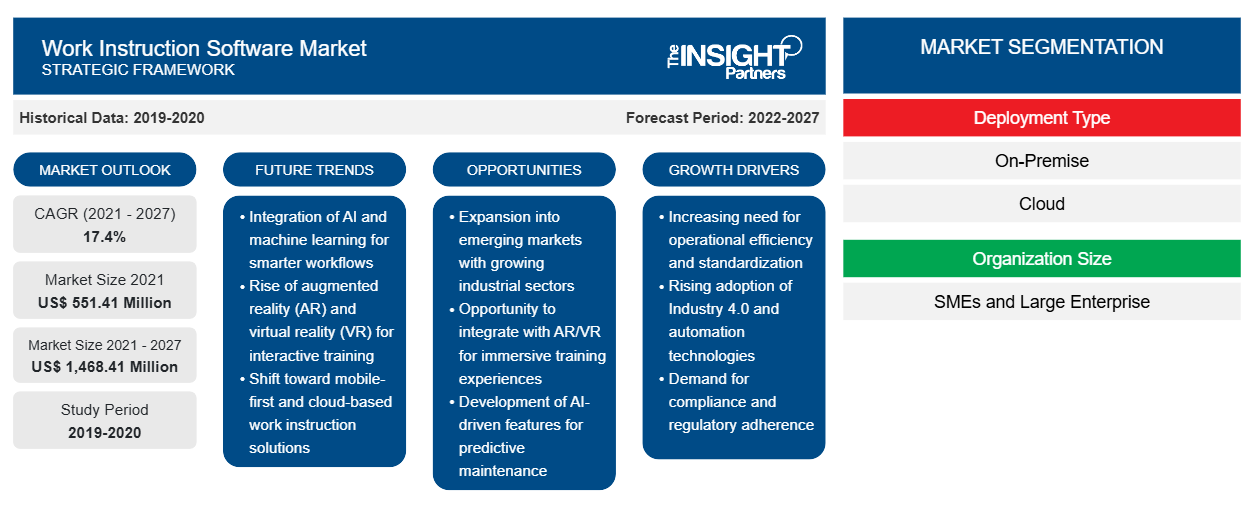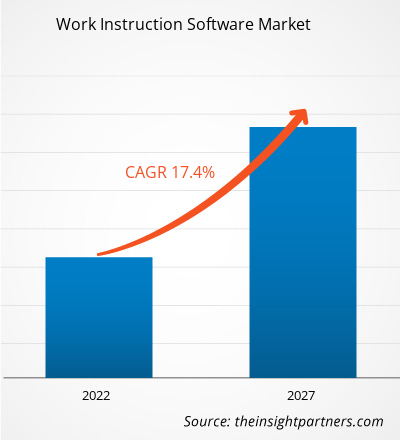Se espera que el mercado de software de instrucciones de trabajo crezca de US$ 551,41 millones en 2021 a US$ 1.468,41 millones en 2027. Se espera que el mercado de software de instrucciones de trabajo crezca a una CAGR del 17,4% durante el período de pronóstico de 2020 a 2027.
El factor clave que impulsa el mercado es la complejidad empresarial y de producción en constante cambio. La adopción de un proceso de producción de modelos mixtos para mejorar la productividad de fabricación de la organización en general está creando la necesidad de una mejor capacitación y desarrollo entre los empleados. Esto, por lo tanto, está impulsando la adopción de software de instrucciones de trabajo en todo el sector manufacturero. La necesidad de capacitación de los empleados para mejorar la productividad está llevando a la adopción de soluciones tecnológicamente avanzadas en todas las empresas. La mayor complejidad del proceso de trabajo en industrias como la fabricación, la automoción, la atención médica y el comercio minorista está aumentando la demanda de instrucciones de trabajo entre los empleados y los trabajadores para realizar su tarea de forma independiente y eficiente. Por ejemplo, Augmentir, Inc. ofrece una plataforma de fuerza laboral conectada impulsada por inteligencia artificial para ayudar a los empleados con flujos de trabajo digitales y orientación remota durante todo el proceso de trabajo.
Con la propagación de la pandemia de COVID-19 por todo el mundo, se está haciendo evidente que pocos pueden escapar de su alcance, lo que presenta desafíos significativos para todas las industrias. Sin embargo, la principal aplicación del software es en el sector manufacturero, donde se aplica para impartir capacitación a los empleados sobre el funcionamiento de ciertas maquinarias. Por lo tanto, se espera que el cierre de todas las unidades de fabricación en los países desarrollados y en desarrollo afecte negativamente al crecimiento del mercado de software de instrucción laboral .
Según el tipo de implementación, el software de instrucciones de trabajo se segmenta en local y en la nube. Se espera que las soluciones basadas en la nube crezcan con la CAGR más alta durante el período de pronóstico. Además, el mercado de software de instrucciones de trabajo según el tamaño de la organización se segmenta en pymes y grandes empresas. Las grandes empresas representaron la mayor participación en el mercado. El mercado global de software de instrucciones de trabajo se ha segmentado en cinco regiones principales: América del Norte, Europa, APAC, MEA y SAM.
Personalice este informe según sus necesidades
Obtendrá personalización en cualquier informe, sin cargo, incluidas partes de este informe o análisis a nivel de país, paquete de datos de Excel, así como también grandes ofertas y descuentos para empresas emergentes y universidades.
- Obtenga las principales tendencias clave del mercado de este informe.Esta muestra GRATUITA incluirá análisis de datos, desde tendencias del mercado hasta estimaciones y pronósticos.
Perspectivas del mercado del software de instrucciones de trabajo
Cambio de la cultura laboral en toda la organización
La creciente tendencia de Bring Your Own Device (BYOD) junto con la cultura de trabajo remoto en las organizaciones, especialmente en las grandes empresas, está creando la necesidad de soluciones de instrucción laboral para garantizar el funcionamiento sin problemas dentro de la organización. La cultura de trabajo flexible en las organizaciones ha llevado a la no presencia de empleados en las oficinas, lo que provoca interrupciones en el flujo de trabajo, especialmente para los empleados de nivel junior que requieren asistencia continua para aprender y ejecutar trabajos para la adquisición de objetivos. La integración de soluciones de instrucción laboral en las organizaciones permite a los empleadores instruir a todos los empleados sin dejar que la barrera física afecte la eficiencia de la producción.
Información del mercado basada en el tipo de implementación
Según el tipo de implementación, el mercado mundial de software de instrucciones de trabajo se segmenta en implementación basada en la nube y en las instalaciones. El software de instrucciones de trabajo basado en la nube está experimentando una gran demanda en comparación con el software de instrucciones de trabajo en las instalaciones. El segmento de la nube genera la mayor parte de la demanda, ya que es comparativamente menos costoso y debido a la sólida infraestructura de red en los países desarrollados. Además, los proveedores de software de instrucciones de trabajo basado en la nube están muy centrados en el desarrollo de un parche de seguridad de alto nivel para eliminar el riesgo de ciberataques. Este factor también está creando una demanda significativa de los usuarios finales, lo que impulsa el mercado de software de instrucciones de trabajo.
Perspectivas del mercado basadas en el tamaño de las organizaciones
Según el tamaño de la organización, el mercado de software de instrucciones de trabajo se segmenta en pymes y grandes empresas. La creciente inversión en infraestructura de fabricación tanto en países desarrollados como en desarrollo está impulsando significativamente la demanda de software de instrucciones de trabajo entre las pymes.
Los actores que operan en el mercado de software de instrucciones de trabajo se centran en estrategias, como iniciativas de mercado, adquisiciones y lanzamientos de productos, para mantener sus posiciones en el mercado de software de instrucciones de trabajo. Algunos desarrollos de los actores clave del mercado de software de instrucciones de trabajo son:
En abril de 2020, SwipeGuide se asoció con XMReality para implementar instrucciones de trabajo digitales mediante soporte remoto.
En octubre de 2019, Georg Fischer Signet implementó AssemblyX de Lifecycle Technology Ltd para la instrumentación del trabajo.
Perspectivas regionales del mercado de software de instrucciones de trabajo
Los analistas de Insight Partners explicaron en detalle las tendencias y los factores regionales que influyen en el mercado de software de instrucción laboral durante el período de pronóstico. Esta sección también analiza los segmentos y la geografía del mercado de software de instrucción laboral en América del Norte, Europa, Asia Pacífico, Oriente Medio y África, y América del Sur y Central.

- Obtenga datos regionales específicos para el mercado de software de instrucción laboral
Alcance del informe de mercado del software de instrucciones de trabajo
| Atributo del informe | Detalles |
|---|---|
| Tamaño del mercado en 2021 | US$ 551,41 millones |
| Tamaño del mercado en 2027 | US$ 1.468,41 millones |
| CAGR global (2021-2027) | 17,4% |
| Datos históricos | 2019-2020 |
| Período de pronóstico | 2022-2027 |
| Segmentos cubiertos | Por tipo de implementación
|
| Regiones y países cubiertos | América del norte
|
| Líderes del mercado y perfiles de empresas clave |
|
Densidad de actores del mercado de software de instrucciones de trabajo: comprensión de su impacto en la dinámica empresarial
El mercado de software de instrucciones de trabajo está creciendo rápidamente, impulsado por la creciente demanda de los usuarios finales debido a factores como la evolución de las preferencias de los consumidores, los avances tecnológicos y una mayor conciencia de los beneficios del producto. A medida que aumenta la demanda, las empresas amplían sus ofertas, innovan para satisfacer las necesidades de los consumidores y aprovechan las tendencias emergentes, lo que impulsa aún más el crecimiento del mercado.
La densidad de actores del mercado se refiere a la distribución de las empresas o firmas que operan dentro de un mercado o industria en particular. Indica cuántos competidores (actores del mercado) están presentes en un espacio de mercado determinado en relación con su tamaño o valor total de mercado.
Las principales empresas que operan en el mercado de software de instrucción de trabajo son:
- Tecnología de ciclo de vida Ltd.
- Gestión del conocimiento Livepro
- Guía de deslizamiento
- ScreenSteps, LLC
- Compartir conocimiento visual Ltd.
Descargo de responsabilidad : Las empresas enumeradas anteriormente no están clasificadas en ningún orden particular.

- Obtenga una descripción general de los principales actores clave del mercado de software de instrucciones de trabajo
Mercado de software de instrucciones de trabajo: por tipo de implementación
- Nube
- En las instalaciones
Mercado de software de instrucciones de trabajo: por tamaño de la organización
- Grandes empresas
- PYMES
Mercado de software de instrucciones de trabajo por geografía
- América del norte
- A NOSOTROS
- Canadá
- México
- Europa
- Francia
- Alemania
- Rusia
- Reino Unido
- Italia
- Resto de Europa
- Asia Pacífico (APAC)
- Porcelana
- India
- Japón
- Australia
- Corea del Sur
- Resto de APAC
- Ministerio de Asuntos Exteriores
- Arabia Saudita
- Emiratos Árabes Unidos
- Sudáfrica
- Resto de MEA
- SAM
- Brasil
- Argentina
- Resto de SAM
Mercado de software de instrucciones de trabajo: perfiles de empresas
- Dozuki
- Sistemas eFlex
- Hexágono AB
- Tecnología de ciclo de vida Ltd.
- Gestión del conocimiento Livepro
- Software de Optel
- ScreenSteps, LLC
- Guía de deslizamiento
- Compartir conocimiento visual Ltd.
- Zaptic
- Análisis histórico (2 años), año base, pronóstico (7 años) con CAGR
- Análisis PEST y FODA
- Tamaño del mercado Valor/volumen: global, regional, nacional
- Industria y panorama competitivo
- Conjunto de datos de Excel



Report Coverage
Revenue forecast, Company Analysis, Industry landscape, Growth factors, and Trends

Segment Covered
This text is related
to segments covered.

Regional Scope
North America, Europe, Asia Pacific, Middle East & Africa, South & Central America

Country Scope
This text is related
to country scope.
Preguntas frecuentes
Based on enterprise size, the work instructions software market is segmented into SMEs and large enterprises. In 2019, large enterprises segment led the work instructions software market. The benefits conferred by work instruction software such as simplifying complex operation processes and real-time visibility are attracting large enterprises to adopt the work instruction software. In any organization, the manufacturing processes is considered as a core component. With the expansion of large enterprises, the manufacturing process and operation of machineries become complex. Work instruction software helps to address all concerns related to regulations, process, and machinery handling, but it is also vital to ensure that the solution selected comprise the right functionality. The market for work instruction software for large enterprises is well-established and is expected to dominate the market during the forecast period.
In terms of revenue share, North America held the largest share of global work instructions software market in 2019 and it is anticipated to continue its dominance over the forecast period of 2020 to 2027. Europe is the second largest revenue contributor, followed by APAC in 2019. The presence of developed countries such as US and Canada coupled with strong industry base is the major factors responsible for high adoption of work instructions software in the North America region.
Further, rise in investments by North American countries, such as the US and Canada, in improving and innovating business processes to offer premium quality products is increasing the need for providing continuous training or real-time assistance to their employees in order to ensure error-free process execution. This is increasing the demand for work instruction software across the region.
Rising demand for training programs across manufacturing industry coupled with the changing work culture across organization are some of the key driving factors for global work instructions software market. Furthermore, constantly changing business and production complexities, and integration of technologies such as augmented reality and artificial intelligence in work instruction software will provide ample growth opportunities to market players operating in the global work instructions software market.
Trends and growth analysis reports related to Technology, Media and Telecommunications : READ MORE..
The List of Companies - Work instructions software market
- Lifecycle Technology Ltd
- Livepro Knowledge Management
- SwipeGuide
- ScreenSteps, LLC
- Visual Knowledge Share Ltd.
- Zaptic
- Hexagon AB
- Dozuki
- eFlex Systems
- Optel Software
The Insight Partners performs research in 4 major stages: Data Collection & Secondary Research, Primary Research, Data Analysis and Data Triangulation & Final Review.
- Data Collection and Secondary Research:
As a market research and consulting firm operating from a decade, we have published and advised several client across the globe. First step for any study will start with an assessment of currently available data and insights from existing reports. Further, historical and current market information is collected from Investor Presentations, Annual Reports, SEC Filings, etc., and other information related to company’s performance and market positioning are gathered from Paid Databases (Factiva, Hoovers, and Reuters) and various other publications available in public domain.
Several associations trade associates, technical forums, institutes, societies and organization are accessed to gain technical as well as market related insights through their publications such as research papers, blogs and press releases related to the studies are referred to get cues about the market. Further, white papers, journals, magazines, and other news articles published in last 3 years are scrutinized and analyzed to understand the current market trends.
- Primary Research:
The primarily interview analysis comprise of data obtained from industry participants interview and answers to survey questions gathered by in-house primary team.
For primary research, interviews are conducted with industry experts/CEOs/Marketing Managers/VPs/Subject Matter Experts from both demand and supply side to get a 360-degree view of the market. The primary team conducts several interviews based on the complexity of the markets to understand the various market trends and dynamics which makes research more credible and precise.
A typical research interview fulfils the following functions:
- Provides first-hand information on the market size, market trends, growth trends, competitive landscape, and outlook
- Validates and strengthens in-house secondary research findings
- Develops the analysis team’s expertise and market understanding
Primary research involves email interactions and telephone interviews for each market, category, segment, and sub-segment across geographies. The participants who typically take part in such a process include, but are not limited to:
- Industry participants: VPs, business development managers, market intelligence managers and national sales managers
- Outside experts: Valuation experts, research analysts and key opinion leaders specializing in the electronics and semiconductor industry.
Below is the breakup of our primary respondents by company, designation, and region:

Once we receive the confirmation from primary research sources or primary respondents, we finalize the base year market estimation and forecast the data as per the macroeconomic and microeconomic factors assessed during data collection.
- Data Analysis:
Once data is validated through both secondary as well as primary respondents, we finalize the market estimations by hypothesis formulation and factor analysis at regional and country level.
- Macro-Economic Factor Analysis:
We analyse macroeconomic indicators such the gross domestic product (GDP), increase in the demand for goods and services across industries, technological advancement, regional economic growth, governmental policies, the influence of COVID-19, PEST analysis, and other aspects. This analysis aids in setting benchmarks for various nations/regions and approximating market splits. Additionally, the general trend of the aforementioned components aid in determining the market's development possibilities.
- Country Level Data:
Various factors that are especially aligned to the country are taken into account to determine the market size for a certain area and country, including the presence of vendors, such as headquarters and offices, the country's GDP, demand patterns, and industry growth. To comprehend the market dynamics for the nation, a number of growth variables, inhibitors, application areas, and current market trends are researched. The aforementioned elements aid in determining the country's overall market's growth potential.
- Company Profile:
The “Table of Contents” is formulated by listing and analyzing more than 25 - 30 companies operating in the market ecosystem across geographies. However, we profile only 10 companies as a standard practice in our syndicate reports. These 10 companies comprise leading, emerging, and regional players. Nonetheless, our analysis is not restricted to the 10 listed companies, we also analyze other companies present in the market to develop a holistic view and understand the prevailing trends. The “Company Profiles” section in the report covers key facts, business description, products & services, financial information, SWOT analysis, and key developments. The financial information presented is extracted from the annual reports and official documents of the publicly listed companies. Upon collecting the information for the sections of respective companies, we verify them via various primary sources and then compile the data in respective company profiles. The company level information helps us in deriving the base number as well as in forecasting the market size.
- Developing Base Number:
Aggregation of sales statistics (2020-2022) and macro-economic factor, and other secondary and primary research insights are utilized to arrive at base number and related market shares for 2022. The data gaps are identified in this step and relevant market data is analyzed, collected from paid primary interviews or databases. On finalizing the base year market size, forecasts are developed on the basis of macro-economic, industry and market growth factors and company level analysis.
- Data Triangulation and Final Review:
The market findings and base year market size calculations are validated from supply as well as demand side. Demand side validations are based on macro-economic factor analysis and benchmarks for respective regions and countries. In case of supply side validations, revenues of major companies are estimated (in case not available) based on industry benchmark, approximate number of employees, product portfolio, and primary interviews revenues are gathered. Further revenue from target product/service segment is assessed to avoid overshooting of market statistics. In case of heavy deviations between supply and demand side values, all thes steps are repeated to achieve synchronization.
We follow an iterative model, wherein we share our research findings with Subject Matter Experts (SME’s) and Key Opinion Leaders (KOLs) until consensus view of the market is not formulated – this model negates any drastic deviation in the opinions of experts. Only validated and universally acceptable research findings are quoted in our reports.
We have important check points that we use to validate our research findings – which we call – data triangulation, where we validate the information, we generate from secondary sources with primary interviews and then we re-validate with our internal data bases and Subject matter experts. This comprehensive model enables us to deliver high quality, reliable data in shortest possible time.


 Obtenga una muestra gratuita de este informe
Obtenga una muestra gratuita de este informe